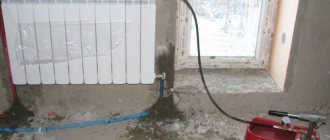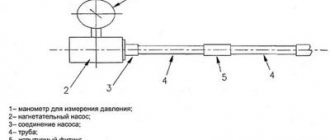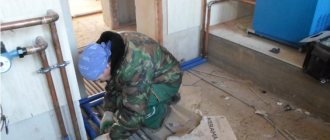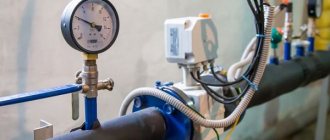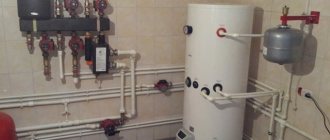In what cases is it compiled?
- Commissioning of new equipment. The certificate will confirm that each element is in its place, the installation was carried out responsibly, and the system is working.
- The heating season is approaching. After a summer break in work, the pipes could fail. After checking their capacity, a report is drawn up.
- Already carried out repair work.
- The occurrence of contained emergency situations on the pipeline. In this way, specialists identify the amount of work required and the weak points of the existing heating network.
For the uninterrupted operation of the heating system, preventative control checks and reliable information about the quality functioning of the system upon startup are necessary.
Components of the heating system pressure test report
At the top left is information about the organization that carried out the inspection. Ideally, there should be a signature for approval by the chief power engineer of the heating supply organization.
The top right should contain subscriber information. That is, about who is the client and consumer of heating services. This could be a partnership of residents of a particular house, any organization that occupies the building, the owner of a private house, etc.
It is important to provide names and other information accurately and in detail. In this case, an address is required.
The main part of the act states:
- City.
- The date of signing the act (and the pressure test itself).
- Heat supply organization: its form of ownership, name, full name of the representative.
- Which of the subscriber's representatives accepted the heating system after the test: full name, position.
- To what indicators the pressure in the system was raised is indicated in kgf/cm2.
- To what indicators did it drop after 10 minutes following the shutdown (the units of measurement here are also kgf/cm2, it is also permissible to measure it in mPa if accurate data on this matter is available).
- Whether the system passed or failed the test (the person completing the form needs to highlight the correct option).
The final part consists of the signatures and seals (if any) of the representatives:
- Subscriber.
- Heat supply organization.
- Service organization.
In general, the act of pressure testing the heating system is a convenient primary document, for filling out which the heat supply organization is responsible.
Filling out the first part of the act
Before performing testing (pressure testing) of a finished water pipeline, you must stock up on a report form in which all important data will be entered. The act is an official document from Appendix 1 of SNiP 3.05.04-85. The title of the document sounds like “Act on conducting an acceptance hydraulic test of a pressure pipeline for strength and tightness.”
The very first information that needs to be entered into the document is the city in which the testing work is being carried out and the date of the event. Below is a list of commission members who will test the internal/external water supply system.
As a rule, the commission should include:
- A representative of the organization that installed all communications;
- Representative from the customer's technical supervision service;
- Person representing the operating organization.
Moreover, it is worth registering the organization that the commission member represents, his position in it, and his last name with initials.
How to draw up a heating system pressure test report - rules for completing the form
After completion of work related to pressure testing of the heating system, a special document is drawn up confirming that the heat supply structure is ready for winter. A special form is provided for this. It is called the act of pressure testing the heating system.
The main task of this type of plumbing work is to test the quality of the pipeline assembly, determine how ready it is for operation, and check the tightness of all joints. If defects are identified that were not visible during external inspection, they should be eliminated.
This is important to know: Debt for housing and communal services: statute of limitations according to the law of 2021
Pressure testing is considered an important stage in the arrangement of heat supply in buildings for a wide variety of purposes.
This work is performed in certain situations:
- before the start of the autumn - winter season;
- after completing the installation of the new heating circuit;
- when the repair or reconstruction of the entire heating main or its section is completed;
- after construction work carried out in the building.
Types of crimping
This process is a test of a heat supply system, which involves increasing the pressure in the pipeline by injecting air or liquid, distinguishing between:
- Hydraulic pressure testing performed using pumps that supply water to the system. As a result, information is obtained regarding its strength.
- Pneumatic testing, which allows you to evaluate the tightness of the joints of the structure as a whole. It is performed using electric or hand pumps that force air into the pipes.
The most dangerous of them is considered to be a pneumatic test, and this circumstance must be taken into account, since the injected air, in the presence of any damage, will not only begin to quickly escape, but there will also be a possibility of gusts. Experts advise not to exceed the supply air pressure above 0.15 MPa.
Installation, repair and maintenance of boilers and dispensers
Heating system tests
carried out after completion of installation work. But first, all plumbing systems must be flushed.
Before testing, the compliance of the heating system
project, carry out an external inspection of pipelines, connections, equipment, instruments, fittings.
Heating systems are tested
in general and individual types of equipment, and also regulate them. Based on the test results, reports are drawn up.
Testing of heating systems, heat supply
performed by hydrostatic and manometric (pneumatic) methods.
Hydrostatic testing of the heating system
is carried out by filling all elements of the system with water (with complete removal of air), increasing the pressure to test pressure, holding the system under test pressure for a certain time, reducing the pressure and, if necessary, emptying the system. Hydrostatic testing is safe: the system is tested under conditions closest to operating conditions. However, such a test requires water to be supplied to the building to fill the plumbing system, which is unacceptable. If the tightness is broken, flooding of premises and soaking of building structures is possible; In winter, water in the pipes may freeze and “defrost”.
Therefore, hydrostatic testing of heating systems
, heat supply, boilers, water heaters are performed at a positive temperature in the premises of the building. The temperature of the water used to fill the system must not be lower than 278°K (5°C).
Hydrostatic heating tests
carried out before finishing the premises.
Pressure testing of the heating system
In many respects, they do not have the disadvantages of hydrostatic tests, but they are more dangerous, since if pipelines or system elements are accidentally destroyed under the influence of compressed air, their pieces can fall into the people conducting the tests.
Gauge heating tests
carried out by filling
the heating system
with compressed air at a pressure equal to the test one, and maintaining it under this pressure for a certain period, then the pressure is reduced to atmospheric pressure.
For testing, a pneumohydraulic unit TSTM-10 is used in the form of a biaxial trailer, on which a tank with a volume of 2.5 m3 and all testing equipment are mounted.
Heating systems testing
.
Acceptance of heating boiler rooms is carried out on the basis of the results of hydrostatic or pressure testing, and heating systems
- on the basis of the results of hydrostatic and thermal tests, as well as external inspection of installed devices and equipment.
Heating systems
are tested for tightness (but not for strength) by the manometric method under an excess air pressure of 0.15 MPa to detect installation defects by ear and then with a pressure of 0.1 MPa for 5 minutes (in this case, the pressure should not decrease by more than 0. 01 MPa).
Hydrostatic testing of a water heating system
carried out upon completion of its installation and inspection. To do this, fill the system with water and completely remove air from it by opening all air collectors, taps on risers and at heating devices. Fill the system through the return line, connecting it to a permanent or temporary water supply. After filling the system, close all air collectors and turn on a manual or driven hydraulic press, which creates the required pressure.
Water heating systems
are subjected to hydrostatic pressure equal to 1.5 working pressure, but not less than 0.2 MPa at the lowest point. During the test, the boilers and expansion vessel are disconnected from the system. The pressure drop during the test should not exceed 0.02 MPa for 5 minutes. The pressure is monitored with a tested and sealed pressure gauge with scale divisions at 0.01 MPa. Any minor faults found that do not interfere with the hydrostatic test are marked with chalk and then corrected.
A pressure gauge is a device that determines the pressure of liquids and gases. The principle of its operation is based on balancing the action of a gaseous or liquid medium by the deformation force of a membrane or spring. This device is one of the mandatory elements for monitoring the parameters of most engineering communications. Thus, a pressure gauge for a heating system is needed to monitor excess pressure inside the boiler and pipes (see Pressure in the heating system of a private house). At the same time, they are capable of simply informing about the state of the coolant and transmitting a signal that blocks the operation of equipment in order to prevent an emergency.
Pressure test sequence for the heating system
This type of work must be planned in advance and therefore, before carrying out the work, appropriate documentation is drawn up:
- The work order is a permit signed by the responsible person of the organization servicing the heating network.
- A diagram of the sections of the heating main where the test will be carried out, indicating the pressure release points.
- List of employees authorized to conduct tests, including the responsible official.
- A diagram of the location of specialists in the area being inspected, indicating the means of communication between them.
- Description of the testing methodology and processing of the obtained data.
Before starting the pumping equipment, perform a visual inspection of the connections and the condition of the shut-off valves. Also, in order to isolate the heating system from the water supply pipeline, plugs are installed.
Then, according to the procedure, the heating boiler and expansion tank are turned off, and the pipes are flushed to remove deposits and debris no more than once every 4–6 years. This procedure must be performed, otherwise, due to the presence of a thick layer of plaque on the inner surface of the pipeline, its thermal conductivity is significantly reduced. Flushing is carried out in different ways depending on the technical condition of the heating structure.
When carrying out hydropressure testing, the flushed system is filled with water, after which a compressor is connected to the drain valve. The pressure is raised to the required value and the readings on the pressure gauge are observed. When there are no weak points in the pipes, which usually immediately leak, significant pressure fluctuations will not be noticed on the device. If this indicator drops significantly, you should find the location of the leak, which is not difficult to do.
Pneumatic pressure testing is performed using a special pump. To make it easier to find defects at the joints, you need to apply a soap solution to them before testing. The pump is connected to the system and air is forced into the pipes. Subsequent actions are similar to those during hydropressure testing. At the same time, it is necessary to remember to comply with safety precautions.
When breaks or loose connections are detected, the defects should be repaired and then checked again. This procedure is repeated until the system becomes completely sealed.
This is important to know: Complaints against the housing and communal services management company: sample statements
Pressure testing is carried out by specialists from organizations that have access, relevant knowledge and skills. They must be able to follow the sequence of work activities while ensuring safety. Finally, fill out the heating system pressure test form.
Carrying out crimp testing
All crimping work is carried out by specially trained personnel using the necessary equipment.
Owners of houses or apartments are strictly prohibited from doing this work with their own hands. Pressure testing begins by filling the heating system with water, if it was empty before. This is done through the return pipeline of the heating network, and more specifically through the elevator. Using valves located at the highest points, air is released until coolant emerges from them.
If a water leak is detected, the system is emptied through the drain valves. The pump for performing pressure testing is connected through the control unit. The person responsible for carrying out the work has a blank form that he fills out during the event. Upon completion, a hydraulic test report of the heating system is issued, as it looks like in the photo.
Documentation of the work performed - act
The pressure test certificate is an official document with legal force confirming that:
- tests were carried out in full according to the program developed by the engineer, in accordance with current standards;
- the heat supply system is in working order and prepared for operation;
- in the event of an emergency during the heating season, one or both parties will be responsible for it, and the culprit will compensate for the damage.
In the form of an act for hydraulic testing of the heating system, there are columns that must be filled out completely and as accurately as possible.
- name of the object being checked;
- date and time of the pressure test;
- the tested area, which can be, for example, a heating main or a separate unit;
- devices used;
- results of visual inspection of joints, seams, etc.;
- the magnitude of the operating pressure and load on the system and the duration of the tests;
- values on the pressure gauge at the end of the test;
- the magnitude of the pressure drop;
- information on eliminating leaks and other defects;
- conclusion that the system is ready for operation;
- signatures of authorized persons.
The heating main pressure test certificate is signed on the day the system was tested. This document must be endorsed by the responsible persons of the enterprise that carried out the work, as well as the technical supervision body and the management company.
Further filling out the act
- After the pressure testing has been carried out, it is necessary to enter data on the nominal gauge pressure for a specific communication and data on the gauge pressure used in testing into the communication leak test report.
- It is also worth indicating the brand of pressure gauge that was used to test and measure the pressure readings in the system at the time of the test. Here it is necessary to indicate the height of the measuring device relative to the axis of the pipes.
- Another parameter that must be included in the leak test report for water supply or sewerage is the time during which the communication leak occurred.
- Further, the document indicates to what nominal value the pressure was reduced after the test. Lastly, members of the commission inspect the pipeline and sewerage and record the results in the report.
- If there were no violations in the tightness of the water supply/sewage system, then in the “Check Results” column it is written down that at the time of the check no leaks or ruptures were found.
- Below is the item “Decision of the Commission”. If the tests are successful, the commission issues permission to put the water supply system into operation.
- Below, all members of the commission must put their signatures indicating their last name and initials, as well as their positions.
WFP 2018/2019
Hydraulic testing is a type of non-destructive testing of equipment strength/density. It is carried out by creating excess pressure with water.
The frequency of hydraulic testing for heating installations and heating networks is 1 year .
The following are subjected to hydraulic tests for thermal energy consumers:
- heating network
- heating points
- heating systems
- heat supply systems for heaters and heaters themselves
- DHW/heating heat exchangers
Hydraulic testing of heating networks
In cases where the heat supply to the facility is carried out from the heating networks of RUE Minskenergo or UE Minskkomunteploseti, the acts are issued by the above-mentioned organizations.
Pay attention to filling out the report; the characteristics of the heating networks (length, diameter, connection point) specified in the hydraulic test report must correspond to the networks on the consumer’s balance sheet in accordance with the act of delimiting the balance sheet ownership of heating networks
